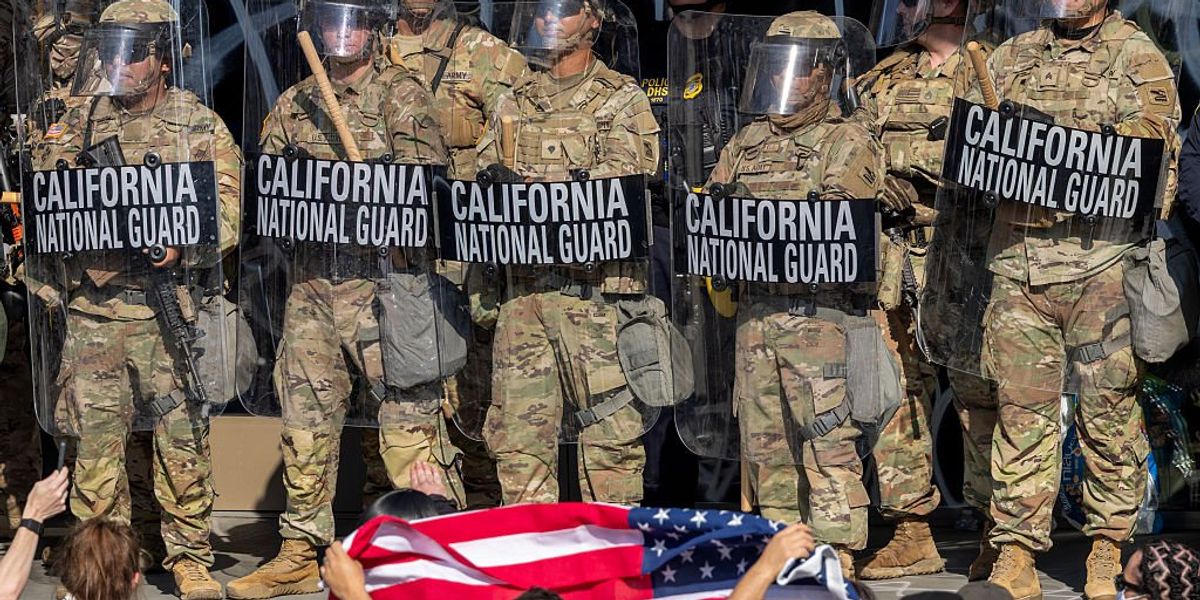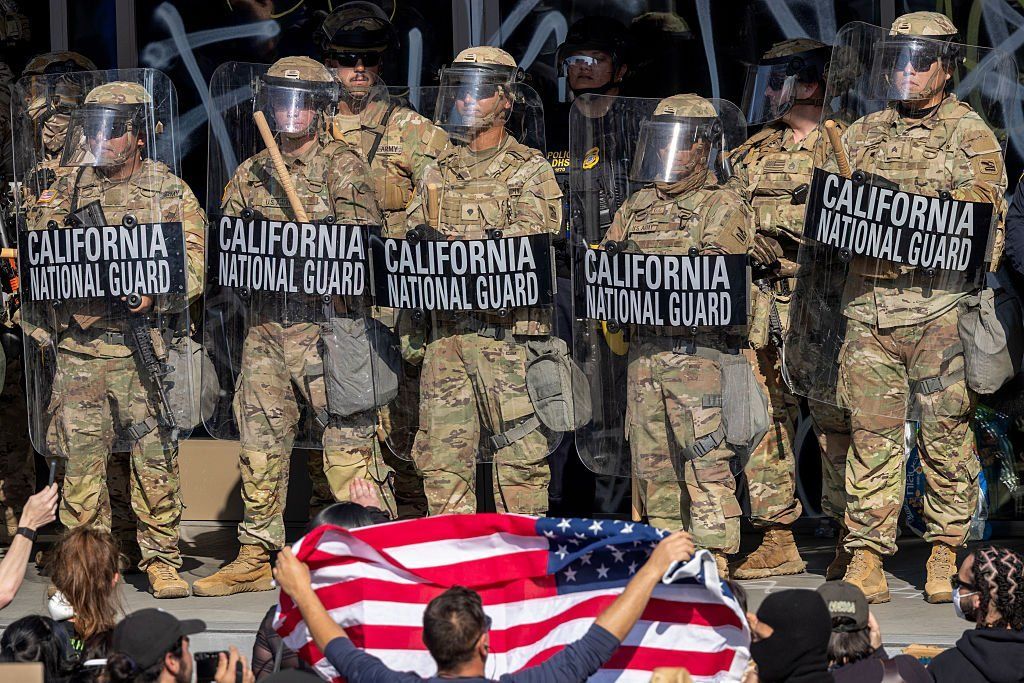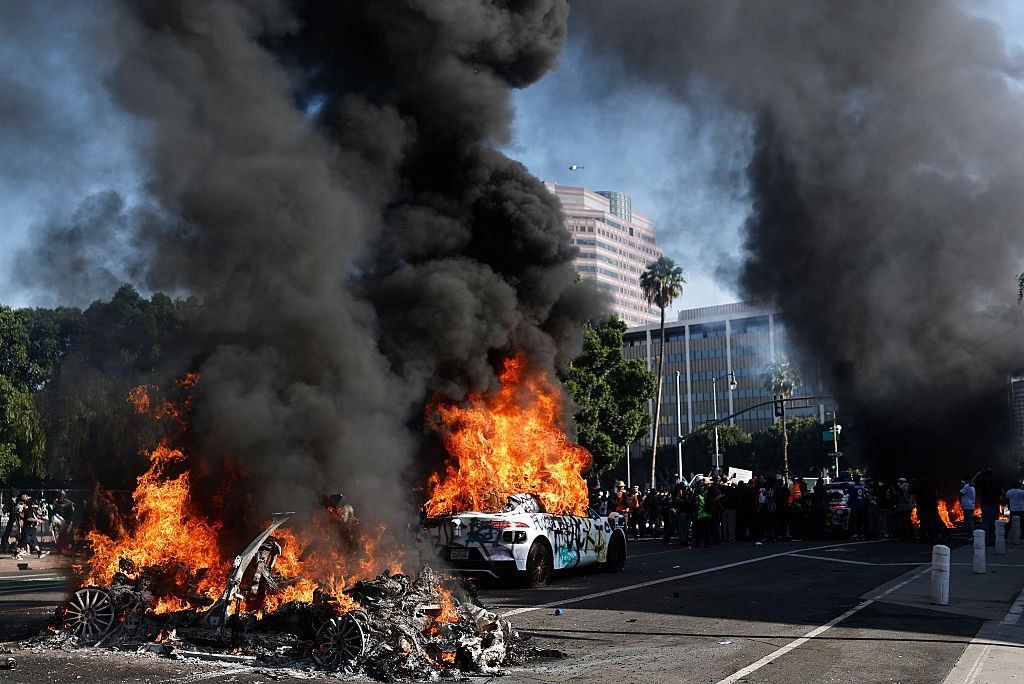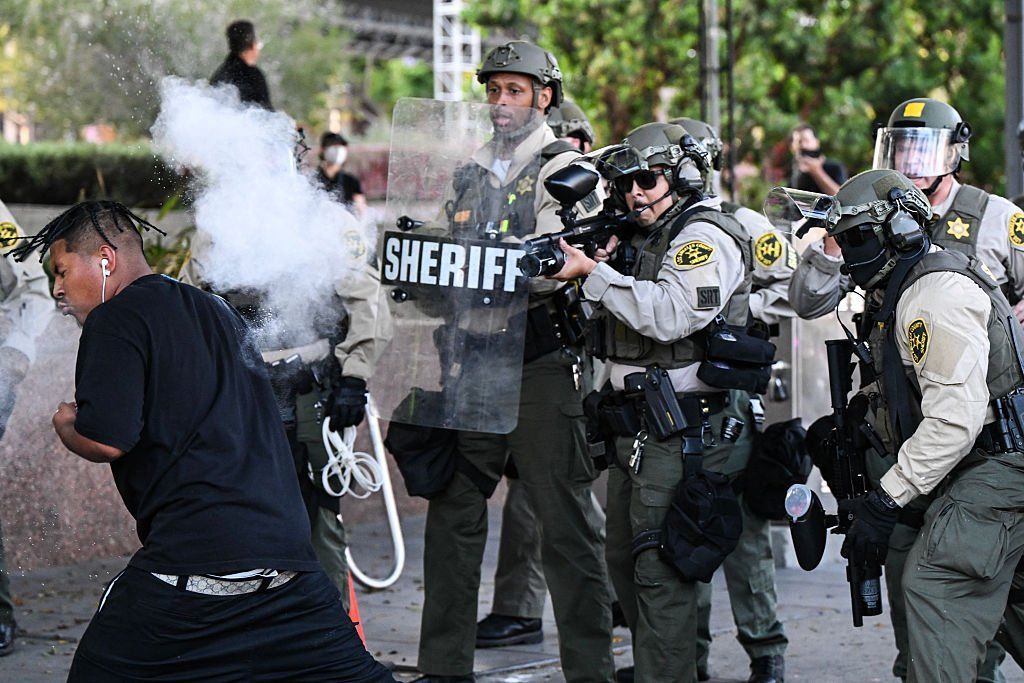

President Donald J. Trump has authority under the U.S. Constitution and federal law to call the National Guard into service for defined purposes that include putting down rebellion, defending against invasion, and ensuring execution of the laws of the United States.
When rioting broke out in and around Los Angeles on June 6 and federal employees and facilities were attacked, President Trump used his constitutional and statutory powers to call 2,000 and later 4,000 members of the California National Guard into federal service.
The DOJ called Gov. Newsom’s court action ‘a crass political stunt.’
Democrat California Gov. Gavin Newsom on June 9 asked a federal district court judge to force the commander in chief to relinquish control of the National Guard, complaining that President Trump had not adequately consulted him.
United States District Judge Charles Breyer, appointee of President Bill Clinton and brother of retired U.S. Supreme Court Justice Stephen Breyer, sided with Newsom in a ruling that was quickly stayed by the U.S. Court of Appeals for the Ninth Circuit. A hearing is set for June 17.
“In a crass political stunt endangering American lives, the Governor of California seeks to use this court to stop the President of the United States from exercising his lawful statutory and constitutional power to ensure that federal personnel and facilities are protected,” wrote Christopher Edelman, senior counsel at the U.S. Department of Justice.
“But, under the Constitution, the president is the commander in chief of the armed forces, and the president is responsible for ensuring the protection of federal personnel and federal facilities,” Edelman wrote in a federal court filing on June 11.
The fight that Newsom started in U.S. District Court for the Northern District of California is shaping up to be more about partisan politics, policy, and lawfare than presidential authority. The U.S. Court of Appeals for the Ninth Circuit quickly stayed a district judge’s ruling that President Trump exceeded his authority. The case will almost certainly end up before the U.S. Supreme Court.
States line up for, against Trump
Attorneys general from Iowa, Oklahoma, South Carolina, Alabama, Arkansas, Florida, Georgia, Guam, Idaho, Indiana, Kansas, Louisiana, Missouri, Montana, Nebraska, North Dakota, South Dakota, Tennessee, Texas, and Utah petitioned to file an amici curiae brief in opposition to Newsom’s attempt to wrestle control of the Guard back from the president.
The states of Washington, Delaware, Arizona, Colorado, Connecticut, Kansas, Hawaii, Illinois, Maine, Maryland, Massachusetts, Michigan, Minnesota, Nevada, New Jersey, New Mexico, New York, North Carolina, Oregon, Vermont, Wisconsin, and Rhode Island moved to file a brief supporting Gov. Newsom.
Newsom complained bitterly in California’s application for a federal temporary restraining order that President Trump and Defense Secretary Pete Hegseth are using a “warrior culture” that targets “the streets of cities and towns where Americans work, go to school, and raise families.”
‘There is no rioters’ veto to enforcement of federal law.’
In his application seeking judicial fiat to regain control of the Guard, Newsom denied the existence of any rebellion or invasion, instead describing the fiery rioting and assaults on federal agents and buildings by supporters of illegal aliens as “civil unrest that is no different from episodes that regularly occur in communities throughout the country that is capable of being contained by state and local authorities working together.”
“Absent immediate injunctive relief, defendants’ use of the military and the federalized National Guard to patrol communities or otherwise engage in general law enforcement activities creates imminent harm to state sovereignty, deprives the state of vital resources, escalates tensions and promotes (rather than quells) civil unrest,” California Attorney General Rob Bonta wrote in the state’s motion for a restraining order.
Corporate media ran interference for Newsom, describing the riots as either “mostly peaceful” or nonexistent. Written and photographic news coverage described President Trump as “hard right” and his immigration policies as “harsh.”
The “working together” cited in Newsom’s court petition was nowhere evident during the more than five days and nights of Los Angeles rioting.
Los Angeles Mayor Karen Bass (D) demanded that federal Immigration and Customs Enforcement agents rounding up illegal aliens for deportation stop their operations. She reportedly ordered the Los Angeles Police Department to stand down during some of the rioting. Democrat politicians encouraged activists to take to the streets, leading to more violence against federal agents and damage to ICE facilities.
In calling up the National Guard and ordering 700 active-duty U.S. Marines to Los Angeles, President Trump judged that Newsom and Bass were unwilling to support the rule of law and protect federal employees, vehicles, facilities, and the general public.
RELATED: Man caught on video passing out face shields to rioters has been arrested, feds say
 Self-driving Waymo vehicles are torched by rioters in Los Angeles on June 8, 2025.Photo by Mario Tama/Getty Images
Self-driving Waymo vehicles are torched by rioters in Los Angeles on June 8, 2025.Photo by Mario Tama/Getty Images
Attorneys for the DOJ insist that the authority to use the military to protect federal agents rests solely with the president, and it is his job alone to determine the measures needed to keep federal employees, facilities, and interests safe from mob rule.
“There is no rioters’ veto to enforcement of federal law,” DOJ Attorney Edelman wrote. “And the President has every right under the Constitution and by statute to call forth the National Guard and Marines to quell lawless violence directed against enforcement of federal law.
“Yet instead of working to bring order to Los Angeles, California and its governor filed a lawsuit in San Francisco seeking a court order limiting the federal government’s ability to protect its property and officials,” Edelman wrote.
Under Section 10 U.S. Code § 12406, the president has authority to use the National Guard to suppress rebellion, repel an invasion, or execute federal laws.
“Plaintiffs admit that Los Angeles has experienced ‘unrest,’ but ask this court to second-guess the president’s judgment that federal reinforcements were necessary,” Edelman wrote. “That is precisely the type of sensitive judgment that is committed to the president’s discretion by law, and to which courts owe the highest deference. The statute empowers the President to determine what forces ‘he considers necessary’ to ‘suppress’ a ‘rebellion’ or to ‘execute’ federal ‘laws’ — not the governor, and not a federal court.”
Judge Breyer’s issuance of a temporary restraining order, quickly stayed by the U.S. Court of Appeals, was a “dangerous” overreach of judicial authority, Edelman suggested.
“The extraordinary relief plaintiffs request would judicially countermand the Commander in Chief’s military directives — and would do so in the posture of a temporary restraining order, no less,” Edelman wrote. “That would be unprecedented. It would be constitutionally anathema. And it would be dangerous.”
Protecting federal agents, facilities
The president’s authority under Section 10 was tailored in this case to protect those engaged in law enforcement functions, such as ICE agents and Department of Homeland Security officers. Neither Guard troops nor Marines were assigned law enforcement duties, so President Trump’s actions do not run afoul of the Posse Comitatus Act, which generally prohibits U.S. military personnel from performing domestic law enforcement functions.
“Plaintiffs offer no contrary evidence, only a speculative assertion that the National Guard and Marines will be used for unlawful purposes in the future,” Edelman wrote.
RELATED: Kamala, Newsom, AOC outed: Leaked DHS memo claims they back violent illegal aliens over Americans
 Los Angeles County Sheriff’s Department deputies fire a nonlethal weapon at a man after he threw a can at them during a protest against federal immigration operations near Los Angeles City Hall on June 11, 2025.Photo by Ronaldo Schemidt/AFP via Getty Images
Los Angeles County Sheriff’s Department deputies fire a nonlethal weapon at a man after he threw a can at them during a protest against federal immigration operations near Los Angeles City Hall on June 11, 2025.Photo by Ronaldo Schemidt/AFP via Getty Images
“Courts did not interfere when President Eisenhower deployed the military to protect school desegregation,” he said. “Courts did not interfere when President Nixon deployed the military to deliver the mail in the midst of a postal strike. And courts should not interfere here either.”
Given the rioting involved, President Trump could have federalized the National Guard by enabling the Insurrection Act. But he chose to work through federal statute in Section 10.
“The statutory lineage of [sub] Section 12406 begins with the First Militia Act of 1792, which, among other things, was used by George Washington to respond to the Whiskey Rebellion,” Edelman wrote.
Farmers in Pennsylvania attacked federal revenue officers when they tried to collect a tax on liquor. A mob of 500 burned down the home of a tax inspector in July 1794, prompting President Washington to call up 13,000 soldiers from four states to put down the rebellion.
The Insurrection Act has been legally invoked 30 times by 17 presidents, according to the Brennan Center for Justice, a New York-based law and policy center.
Like Blaze News? Bypass the censors, sign up for our newsletters, and get stories like this direct to your inbox. Sign up here!















